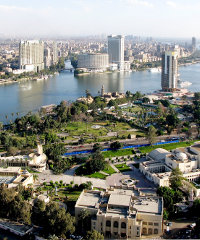What you should know about Egypt’s demographics
Whilst last year’s political turmoil in North Africa may have been off-putting to potential investors in the region, Egypt’s evolving demographics are appealing.

Egypt's capital Cairo
In a recent study by Euromonitor International, Egypt’s population is placed under the spotlight to provide businesses with an insight into where the country’s demographics will be in 2030.
Population
The Egyptian population, currently at around 84 million, is predicted to reach 105 million by 2030, having topped 100 million by 2026, according to Euromonitor’s research.
Almost all age segments will increase, especially the group aged 65 or older, which will expand by 170%, according to Euromonitor. However, the 23-33 year old group is the only segment that will decrease in size and is predicted to fall by 8.3% by 2030. This means that there will be 1.3 million less people between the ages of 23-33 in 2030 than there were in 2010. “This decline is due to a low birth rate between 1997 and 2007 and the impact of emigration,” suggests the research.
However, Euromonitor’s research shows that Egypt will remain a country with a young population with estimates that 42.4% of the population will be aged 20 years or younger by 2030, meaning that this age segment will gain 10.3 million inhabitants between 2010 and 2030.
“In 2030, 29.9% will be under 15 and 54.9% under 30. This is because ageing is being driven by an increase in older age groups rather than a sharp fall in the number of children. In fact, the number of children is set to continue to increase as a result of the large proportion of women of childbearing age, which will remain above 50% of all women until 2017.”
Those who are in the 80 years or older segment are also increasing at a rapid rate. “Between 2010 and 2030 this segment is set to expand by a further 152%,” states the report. “This growth is from a low base, however, and equates to less than 1 million additional inhabitants.”
The median age is estimated to rise from 24.1 years in 2010 to 26 years in 2030. There is also a predicted rise in life expectancy. In 2030, life expectancy from birth is expected to reach 74.9 years, an increase from 70.5 years in 2010 and 62.9 years in 1990.
Like the rest of Africa, Egypt is seeing a gradually expanding middle class that is driving consumer spending, according to a recent note by investment firm Silk Invest.
Last year How we made it in Africa reported on US retailer Gap’s decision to enter Egypt despite the political turmoil of the time. “The rapidly growing consumer base in North Africa provides an ideal environment to introduce both Gap and Banana Republic to the continent,” commented Stephen Sunnucks, president of Gap Inc.’s international division.
Diversity and ethnicity
According to World Bank figures for 2010, Egypt had an immigrant population of 244,700, 0.3% of the total population. Euromonitor highlights Somalia, West Bank and Gaza, Iraq, Saudi Arabia, Libya, Jordan, Indonesia, Sudan, Lebanon and Kuwait as the most common countries of origin. “According to the World Bank some 37.9% are refugees, predominantly from Sudan, Somalia, the West Bank and Gaza, and Iraq. Egypt is also a transit country for illegal immigrants from East Africa heading to Europe or Israel.”
With a large emigrant population, “remittances have acted as a stable source of foreign reserves during the past two years,” stated Silk Invest. “The money that comes in from the diaspora continues to support local consumption.”
The report also shows that Egypt is an ethnically homogenous country. “In 2010, 99.7% of the population were of Eastern Hamitic stock and in 2030 the proportion will be 99.9%.”
In 2010, the official language Arabic was spoken by 98.9% of the population and this figure will only slightly decrease by 0.2% in 2030. “English and French are spoken as second languages and are commonly used in business.”
Population density and urbanisation
Egypt is mostly a rural country, with 56.7% of the population living in rural areas in 2010. However, 2030 is expected to be the first year in which the population will be more urban at 50.5%. According to the UN, almost two thirds of the population is expected to be urban by 2050.
“Egypt’s urban centres are characterised by informal settlements built on agricultural land without planning permission, construction permits and most urban services,” states the research.
“Population density is set to continue increasing. It varies considerably from region to region with the majority of the population living within the Nile Valley and the Delta. The Nile Valley has one of the highest population densities in the world.”

